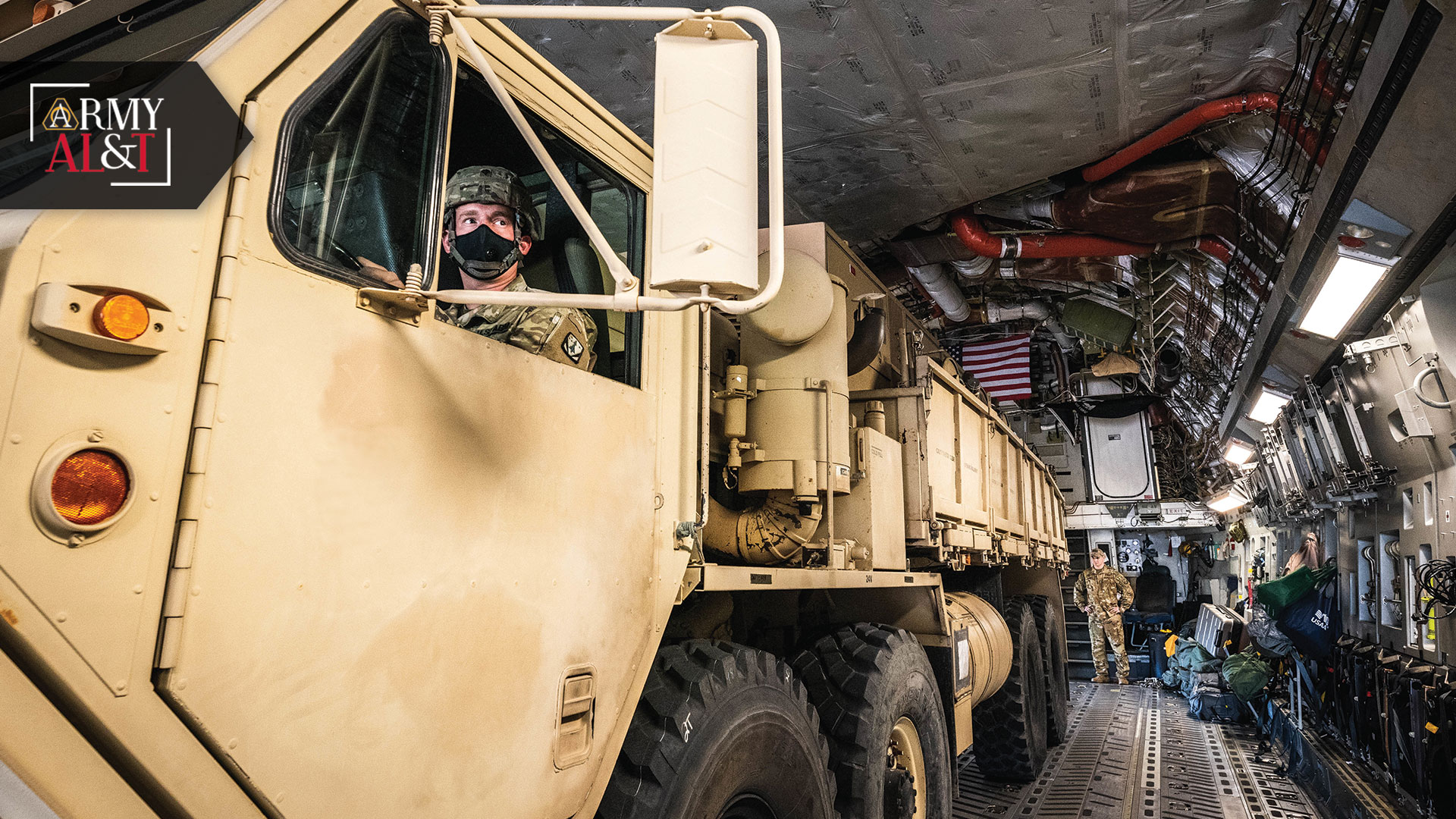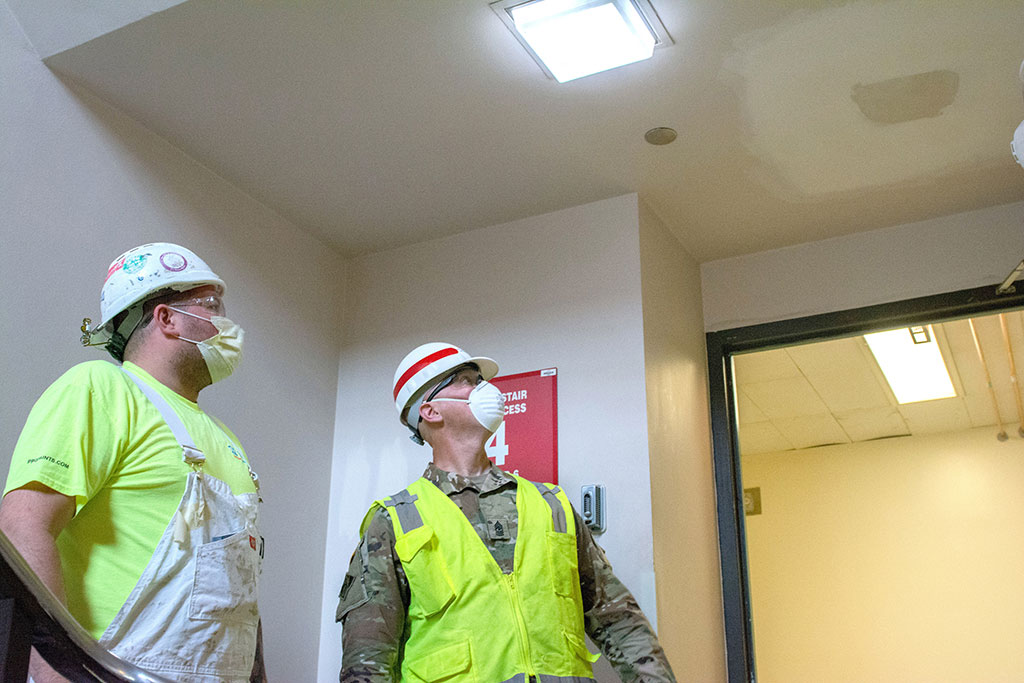
MASK UP: ASA(ALT)’s COVID-19 Task Force is studying the risks and challenges that COVID-19 presents to readiness and modernization. Here, a Soldier wears a face mask to drive an electric power plant onto an aircraft during strategic air load operations May 11 in Lawton, Oklahoma. (Photo by Sgt. Amanda Hunt, 31st Air Defense Artillery Brigade)
FROM THE ARMY
ACQUISITION EXECUTIVE
BRUCE D. JETTE
Pandemic amplifies current challenges of fielding the future force.
When the COVID-19 pandemic emerged earlier this year, our way of life changed dramatically. The Army acquisition, logistics and technology community entered an unprecedented era. We found ourselves fighting an “invisible enemy” that, in its unpredictability, has shown us not only how critical Army acquisition is to fielding the future, but how vital we are to safeguarding the present. It has shown us the importance of planning, preparation and, most importantly, communication among our workforce, across the Army and DOD, and with our industrial base partners.
One of the early steps I took was to appoint Brian Raftery, the acting deputy assistant secretary of the Army for strategy and acquisition reform, as our COVID-19 Task Force lead to enable a comprehensive whole-of-the-organization assessment of the Office of the Assistant Secretary of the Army for Acquisition, Logistics and Technology (ASA(ALT)), including the risks and challenges that COVID-19 presents to readiness and modernization. He and his exceptional team are working closely with the Joint Acquisition Task Force, communicating daily with colleagues throughout the Army and DOD to ensure that we are providing equipment based on established requirements when and where needed to combat COVID-19, as well as mitigating risks to the defense industrial base.
The resilience of our industry partners, including entire supply chains from prime contractors to major subcontractors to lower tiers that include suppliers of parts and raw materials, is essential in providing capabilities to the current, as well as the future, force. To better understand the health and safety issues our contractors face, I asked my COVID-19 Task Force to begin generating a daily summary of pandemic impacts to industry, addressing prime contractors and subcontractors to the lowest level where information is available.

ON THE JOB: A contract painter updates Sgt. Maj. John Nelson, a U.S. Army Reserve Soldier from the 416th Theater Engineer Command (TEC) supporting a U.S. Army Corps of Engineers project to rehabilitate Westlake Hospital in Melrose, Illinois, into an alternate care facility during the COVID-19 pandemic, on April 23. (U.S. Army photo by Sgt. 1st Class Jason Proseus, 416th TEC)
What I receive—and review daily—is a report with more than 60 pages of data on all levels of the supply chain. While contractually our industry partners are not required to furnish this information, they do so readily. This demonstrates the importance of communications. The reason behind my request for this lengthy, in-depth report is to inform Army senior leaders and to assist our industry partners while ensuring the health and safety of their workforces.
For example, steps have been taken to maintain financial stability of critical defense contractors. Progress payments may be expedited for large contractors from 80 percent to 90 percent, and small business payments expedited from 85 percent to 95 percent. In addition, we are also able to change our normal payment period that a customer has to pay their outstanding bill from 30 days to 15 days, so that primes can pay their subcontractors. The Army is committed to making sure we do the right thing to help industry resolve problems and challenges while mitigating the impact of COVID-19.
EYES FORWARD
As I have said on several occasions, you can’t assemble armored vehicles by telephone or computer. You’ve got to have welders in the factory. The Army and our Soldiers are depending on those workers to deliver capabilities, and we want to ensure that they are healthy and safe in fulfilling their commitment to our men and women in uniform.
Part of my official duties and responsibilities is exercising civilian control over the entirety of Army acquisition. Not only are we responsible for programmatic oversight of the Army’s 31-plus-three priority programs, we are also responsible for more than 600 other programs. That means we have a lot of industrial partners to be concerned about.
Indeed, we have industry partners who have had to temporarily close and reopen as a result of the pandemic. There are others who have had to rethink their workspaces or disinfect them between shifts, as we have done in many of our offices. Our prime contractors tend to be larger and more capable of weathering those kinds of events. It’s the smaller companies, with 20 or maybe 30 people who make cables or circuit boards or some other important component of a major weapon system, that are of more concern—if someone becomes ill and has been in close proximity with others, the entire company may lose at least 14 days in quarantine.

WELCOME BACK: Col. Robert F. Howe II, right, commander of the 1st Medical Brigade, elbow-bumps medics returning May 11 to Fort Hood, Texas, from deployment to New York. (U.S. Army photo by Sgt. 1st Class Kelvin Ringold, 13th Expeditionary Sustainment Command)
When something happens to a prime contractor’s supply chain, we work to execute those portions of the program not dependent upon those components. We keep moving forward, as a team. We have been and will continue to be supportive of our industrial base and its supply chains to ensure that they can continue to help us procure existing weapon systems and develop new, priority systems. We are tracking each program, and all appear to be positioned to recover without significant slippage at this writing.
PREPARED AND RESILIENT
People often say that acquisition is a team sport, and I am reminded daily of the importance of teamwork. The ASA(ALT) team is working seamlessly with our Army and DoD counterparts to maintain readiness while combating COVID-19. We are working with our industry partners, not only to help maintain and ensure equipment readiness for the current force, but also in fielding for the future force. I want to thank everyone in the Army’s acquisition enterprise for your hard work, your dedication to our mission and your teamwork.
Always, my top priority is the health and safety of the Army acquisition workforce—all 42,000 professionals—and their families. In March, I directed supervisors to maximize telework and alternate work schedules for all but those whose work absolutely required that they be present in person to meet essential operational requirements. This ability for a large share of our team to work offsite was possible because we had the infrastructure established, the software and hardware, and the foundation upon which to build on the critical nature of our work.

NO SUBSTITUTE: “You can’t assemble armored vehicles by telephone or computer,” says Jette. “You’ve got to have welders in the factory. (Photo by Mark Cleghorn, Anniston Army Depot)
While this pandemic was unforeseen, we already had plans and tools in place to quickly respond to it. As an organization, we were prepared. That, really, is what fielding the future is all about—creating the conditions and putting the tools in place so that our forces of the future will be able to respond to their own crises.
No one can say what “normal” will look like when we get back to it. Nor can anyone say how long that will take. Yet the way that we execute now will enable the creation of the future that we want, and that tells a great deal about the character and resilience of the men and women of the Army acquisition enterprise.
Fielding the future—modernizing the Army—proceeds today because of the resilience of the Army Acquisition Workforce, and the larger enterprise of which we are part. We are here to serve the Soldier.
This article is published in the Summer 2020 issue of Army AL&T magazine.
Subscribe to Army AL&T News – the premier online news source for the Army Acquisition Workforce.
![]() Subscribe
Subscribe







